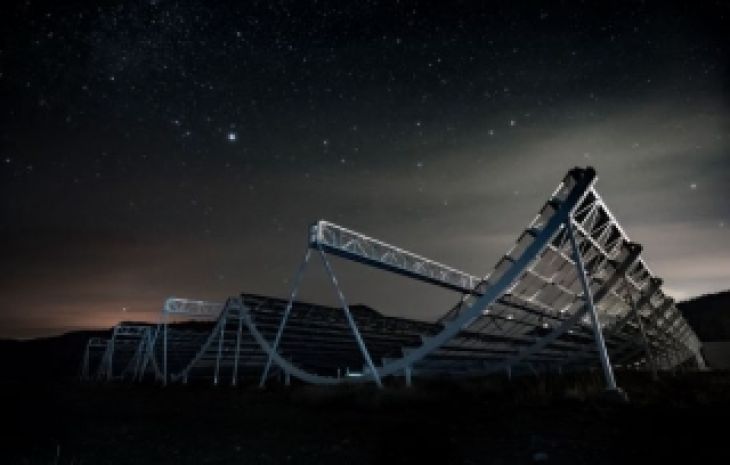Astronomers at McGill University, MIT and elsewhere have detected a strange and persistent radio signal from a far-off galaxy, that appears to be flashing with surprising regularity. Classified as a fast radio burst, or FRB, this new signal persists for up to three seconds, about 1,000 times longer than the average FRB. Within this window, the team detected bursts of radio waves that repeat every 0.2 seconds in a clear periodic pattern.
The researchers have labeled the signal FRB 20191221A. It is currently the longest-lasting FRB, with the clearest periodic pattern, detected to date. The discovery is reported in the journal Nature and is authored by members of the CHIME/FRB Collaboration.
On December 21, 2019, the CHIME telescope picked up a signal of a potential FRB, which immediately drew the attention of Daniele Michilli, who noticed something unusual while scanning the incoming data.
“Not only was it very long, lasting about three seconds, but there were periodic peaks that were remarkably precise, emitting every fraction of a second — boom, boom, boom — like a heartbeat,” recalls Michilli, who led the research, initially while at McGill University and then as a postdoc at MIT. “This is the first time the signal itself is periodic.”
“There are not many things in the universe that emit strictly periodic signals,” adds Aaron Pearlman, a FRQNT postdoctoral fellow at the McGill Space Institute who also collaborated on the paper. “Examples that we know of in our own galaxy are radio pulsars and magnetars, which rotate and produce a beamed emission similar to a lighthouse. And we think this new signal could be a magnetar or pulsar on steroids.”
The team hopes to detect more periodic signals from this source, which could then be used as an astrophysical clock. For instance, the frequency of the bursts, and how they change as the source moves away from Earth, could be used to measure the rate at which the universe is expanding.
Brilliant bursts
In analyzing the pattern of FRB 20191221A’s radio bursts, Michilli and his colleagues found similarities with emissions from radio pulsars and magnetars in our own galaxy. Radio pulsars are neutron stars that emit beams of radio waves, appearing to pulse as the star rotates, while a similar emission is produced by magnetars due to their extreme magnetic fields.
The main difference between the new signal and radio emissions from our own galactic pulsars and magnetars is that FRB 20191221A appears to be more than a million times brighter. Michilli says the luminous flashes may originate from a distant radio pulsar or magnetar that is normally less bright as it rotates and for some unknown reason ejected a train of brilliant bursts, in a rare three-second window that CHIME was luckily positioned to catch.
“CHIME has now detected many FRBs with different properties,” Michilli says. “We’ve seen some that live inside clouds that are very turbulent, while others look like they’re in clean environments. From the properties of this new signal, we can say that around this source, there’s a cloud of plasma that must be extremely turbulent.”
The astronomers hope to catch additional bursts from the periodic FRB 20191221A, which can help to refine their understanding of its source, and of neutron stars in general.
“This detection raises the question of what could cause this extreme signal that we’ve never seen before, and how we can use this signal to study the universe,” Michilli says. “Future telescopes promise to discover thousands of FRBs a month, and at that point we may find many more of these periodic signals.”
“Sub-second periodicity in a fast radio burst” by Bridget Andersen et al. in Nature
DOI: https://doi.org/10.1038/s41586-022-04841-8
Written in collaboration with Jennifer Chu, MIT News Office







